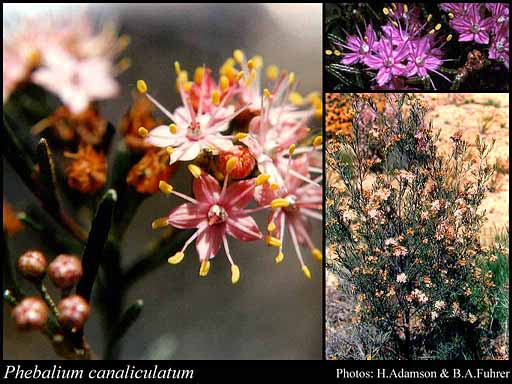- Reference
- Victorian Naturalist 74:169 (1958)
- Conservation Code
- Not threatened
- Naturalised Status
- Native to Western Australia
- Name Status
- Current
Erect or spreading shrub, 0.4-2 m high. Fl. pink/purple-blue/cream-white, May or Jul to Oct. Red or yellow sand, red loam or clay soils. Sandplains, hillslopes.

Scientific Description
Shrub, spines absent; branchlets verrucose (warty), +/- cylindrical in cross-section, covered in hairs or scales, the hairs stellate (star-shaped). Leaves alternate, simple, 5-20 mm long, 1-1.3 mm wide, terete, covered in hairs or scales, with stellate (star shaped) hairs or peltate (umbrella-like) scales; stipular excrescences absent. Flowers in terminal umbels; pedicels 1.5-6 mm long; calyx present, 1-1.5 mm long, smooth, without distinct raised glands, covered in hairs or scales, the hairs peltate scales; corolla pink, purple, white or cream or blue, petals five, 4-5 mm long, imbricate (overlapping), free, lepidote (with scales); stamens twice as many as petals, 2-7 mm long, smooth, glabrous; anthers 1 mm long, without an appendage; style 6.5-7.5 mm long, glabrous. Flowers in May, July, August, September and October. Occurs in the Eremaean and South-West Botanical Province, in the Murchison, Great Victoria Desert, Coolgardie and Avon Wheatbelt IBRA region(s).
Distribution
- IBRA Regions
- Avon Wheatbelt, Coolgardie, Great Victoria Desert, Murchison.
- IBRA Subregions
- Eastern Goldfield, Eastern Murchison, Katanning, Merredin, Shield, Southern Cross.
- Local Government Areas (LGAs)
- Coolgardie, Dalwallinu, Dundas, Kalgoorlie-Boulder, Katanning, Koorda, Menzies, Mount Magnet, Mount Marshall, Mukinbudin, Narembeen, Perenjori, Sandstone, Trayning, Westonia, Wyalkatchem, Yalgoo, Yilgarn.